Malayan dollar facts for kids
The Malayan dollar (Malay: ringgit) was the money used in British-controlled areas of Malaya and Brunei until 1953. It was introduced in 1939, taking the place of the Straits dollar. One Malayan dollar was worth the same as the Straits dollar. It was also equal to two shillings and four pence in British sterling money.
Contents
History of the Malayan Dollar
Who Created the Malayan Dollar?
The Malayan dollar was created and issued by a group called the Board of Commissioners of Currency, Malaya. This group was formed in October 1938. Their main job was to be the only authority allowed to print and issue money for the different Malay States, including Brunei, and the Straits Settlements.
Before this, a person named Sir Basil Phillott Blackett had suggested in 1933 that a single group should handle all the money for these areas. His idea was accepted, and laws were passed in 1938 and 1939 to make the Board official. The Board then started issuing money in 1939.
Later, in 1952, the Board changed its name to the Board of Commissioners of Currency, Malaya and British Borneo. This new board then issued the Malaya and British Borneo dollar.
Early Banknotes and Wartime Challenges
In 1940, banknotes for 1, 5, and 10 dollars were printed in the United Kingdom. They were meant for use in Malaya. However, not all of them arrived safely.
Many 1-dollar and 5-dollar notes were lost at sea. For example, some were lost when the ship SS Automedon was captured and sunk in 1940. More were lost when another ship, the SS Eumanes, was also sunk. Because of these losses, the government of the Straits Settlements never put these specific 1-dollar and 5-dollar notes into use. Only the 10-dollar notes were issued in March 1941.
Money During Japanese Occupation
During World War II, when Japan took control of Malaya (1942–1945), the Japanese government-issue dollar replaced the Malayan dollar as official money.
When the Japanese invaded, some Malayan dollar notes were still kept in vaults in Singapore and Penang. The Japanese captured some of these notes in Penang. In Singapore, many notes were destroyed to prevent them from falling into Japanese hands. Other notes were sent to India for safety.
After the war, in 1946, all the old Malayan dollar notes that had been printed before the war were destroyed. This was done because officials worried that some notes captured by the Germans might have been given to the Japanese. They feared these notes could be secretly held, ready to be used later.
After the War: British Military Rule
British forces returned to Malaya in September 1945. They slowly took back control of the entire region. Until April 1946, the country's money matters were handled by the British military.
The British decided that the Japanese money, often called "banana money," was worthless. This was because the Japanese had printed a huge amount of it. This made the money lose almost all its value.
The British military then put new Malayan dollar notes into circulation. These notes had been printed in Britain either before or during the war. Some older Straits Settlements notes were also allowed to be used for a while. These older notes were slowly taken out of circulation as the new Malayan dollar notes became widely available.
The new notes issued during this time had different dates. For example, notes from 1 cent to 10 dollars were dated 1 July 1941. Higher value notes like 50, 100, and 1,000 dollars were dated 1 January 1942. The 10,000-dollar notes were signed and dated on the day they were issued.
Return to Civilian Control
On April 1, 1946, civilian government returned to Malaya. The Board of Commissioners of Currency Malaya was officially re-established. It continued to manage the currency just as it had before the Japanese occupation.
All banknotes bearing dates prior to 1 July 1941, were officially taken out of circulation on 31 August 1948.
Coins of the Malayan Dollar
Coins for the Malayan dollar were made between 1939 and 1950. They came in different values:
- Square-shaped ½ and 1 cent coins were made of bronze.
- Round 5, 10, and 20 cent coins were made of silver until 1945. From 1948, they were made of a metal mix called cupro-nickel.
These coins looked very similar to the older Straits Settlements coins they replaced. The 1 cent coins were made smaller in 1943 because of the war and the cost of materials. The ½ cent coins were stopped after 1940, but they could still be used. All the coins from this time showed a picture of King George VI. Older Straits coins also continued to be used alongside the new ones.
Banknotes of the Malayan Dollar
As mentioned, 1, 5, and 10-dollar banknotes were printed in the UK in 1940. However, because some shipments were captured during the war, only the 10-dollar notes were widely issued from that first batch.
Because of the war in Europe, the Survey Department in Malaya printed emergency 10 and 25 cent notes for use. These were later replaced in 1941 by notes printed by Thomas de la Rue in denominations of 1, 5, 10, 20, and 50 cents.
When the British regained control of Malaya after World War II, notes were issued in 1945 (but dated 1941). These included values of 1, 5, 10, 50, 100, 1,000, and even 10,000 dollars.
| Cent Notes | |||||||
|---|---|---|---|---|---|---|---|
| Image | Value | Main colour | Description | Date of issue | Printed | ||
| Obverse | Reverse | Obverse | Reverse | ||||
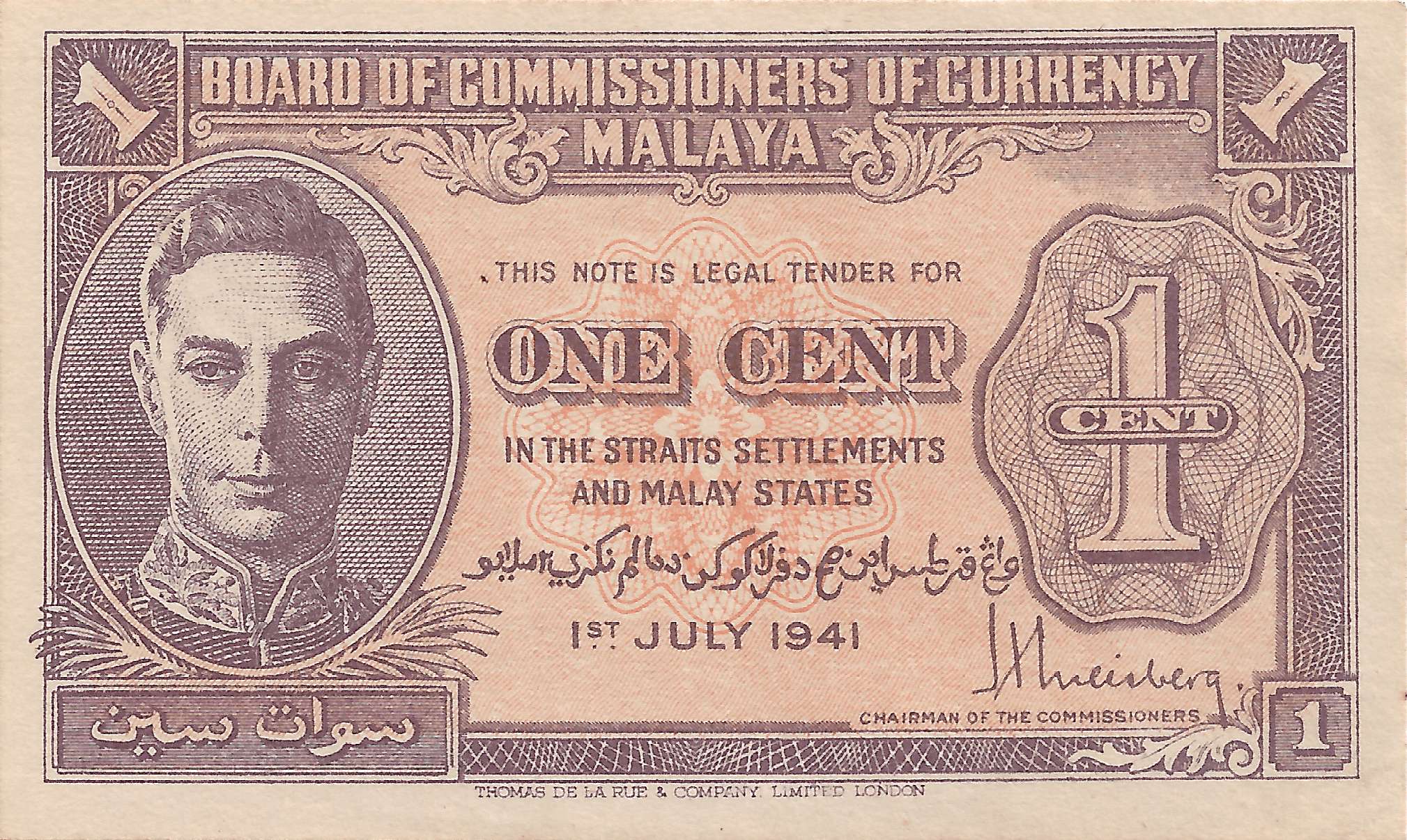 |
Blank | 1 cent | purple/orange | King George VI | blank | 1941 | Thomas De La Rue |
| 5 cents | red/green | blank | 1941 | Thomas De La Rue | |||
| 10 cents | dark blue/pink/brown | blank | 1940 | Survey Department, | |||
| 10 cents | Blue/pink | blank | 1941 | Thomas De La Rue | |||
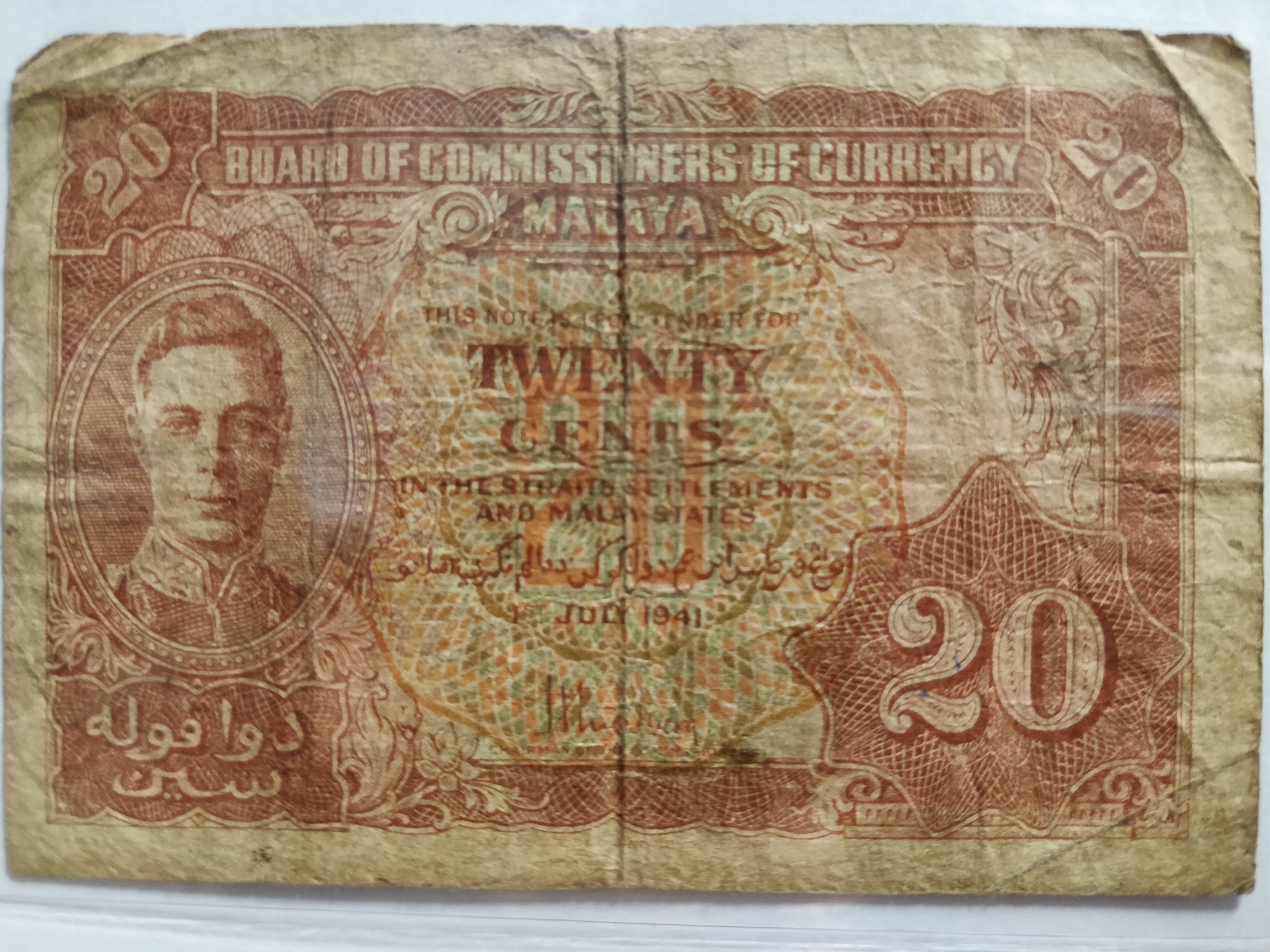 |
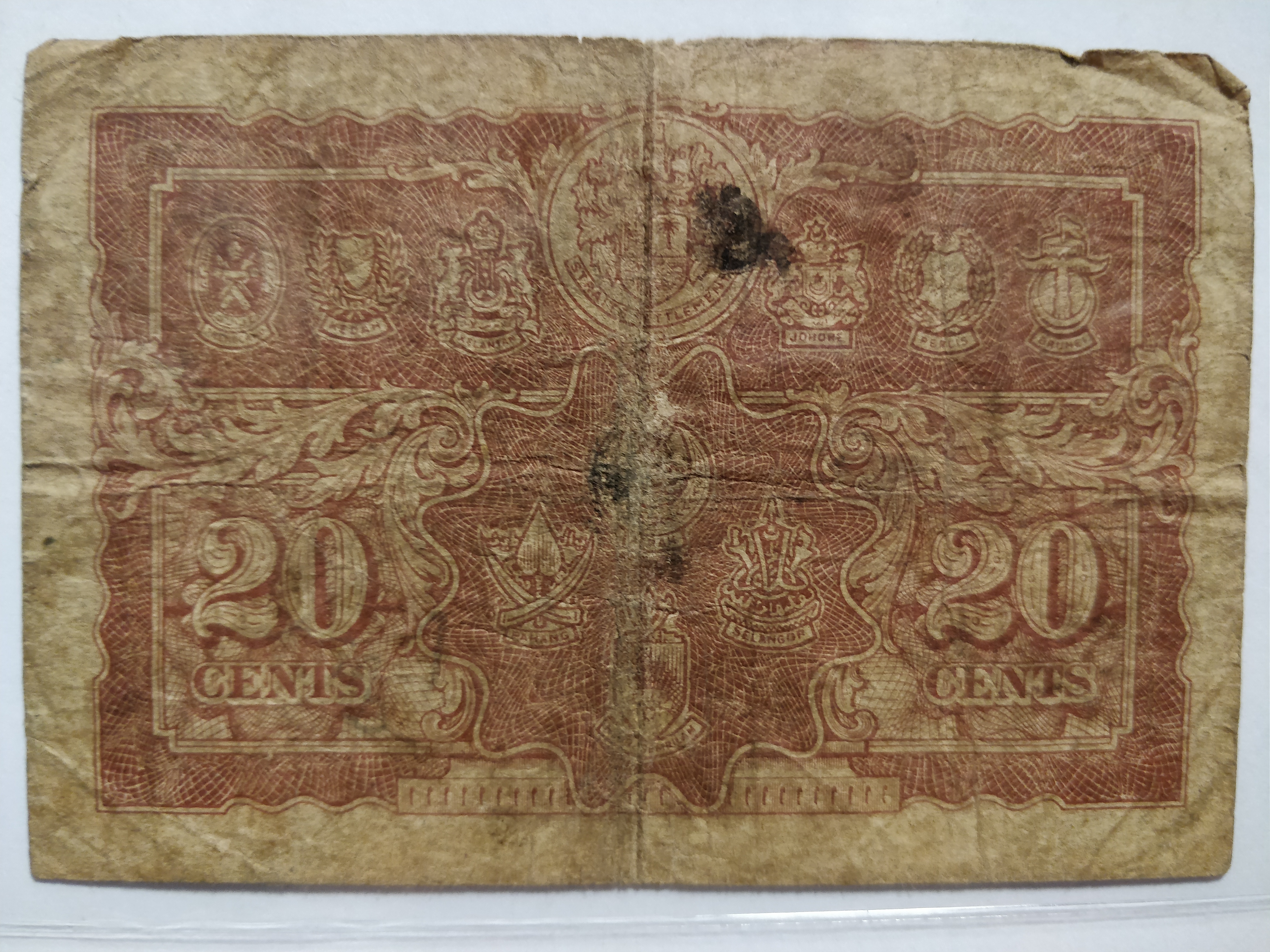 |
20 cents | brown/orange | Coat of arms of the Federated Malay States (left), the Straits Settlements (centre top), and the Unfederated Malay States and Brunei (right). | 1941 | Thomas De La Rue | |
| 25 cents | green/orange | 1940 | Survey Department, | ||||
 |
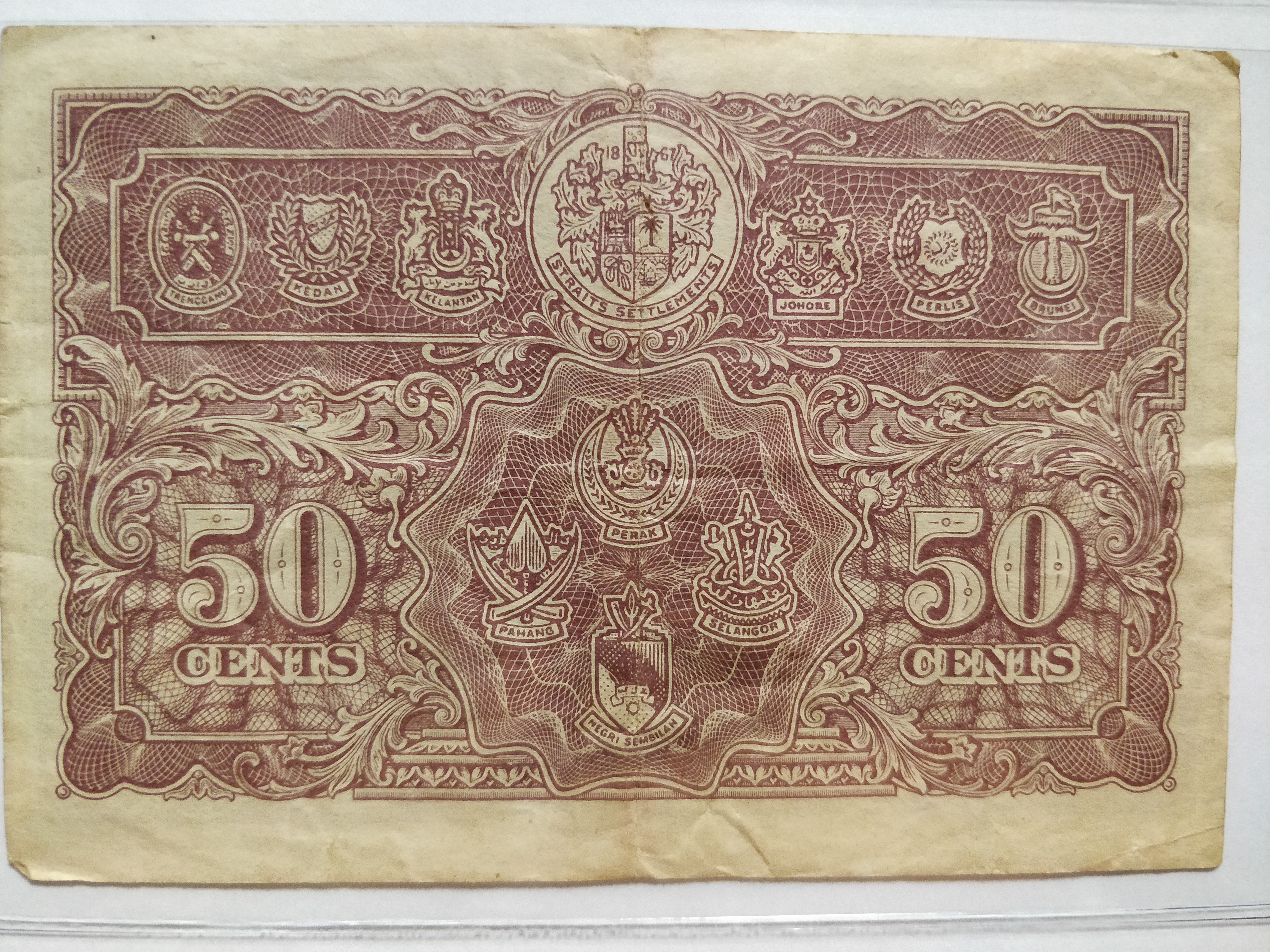 |
50 cents | purple/orange | 1941 | Thomas De La Rue | ||
| Malayan Dollar Notes | ||||||
|---|---|---|---|---|---|---|
| Image | Value | Main colour | Description | Date of issue | ||
| Obverse | Reverse | Obverse | Reverse | |||
| $1 | green | King George VI | Coat of arms of the Federated Malay States (left), the Straits Settlements (centre top), and the Unfederated Malay States and Brunei (right). | 1940 | ||
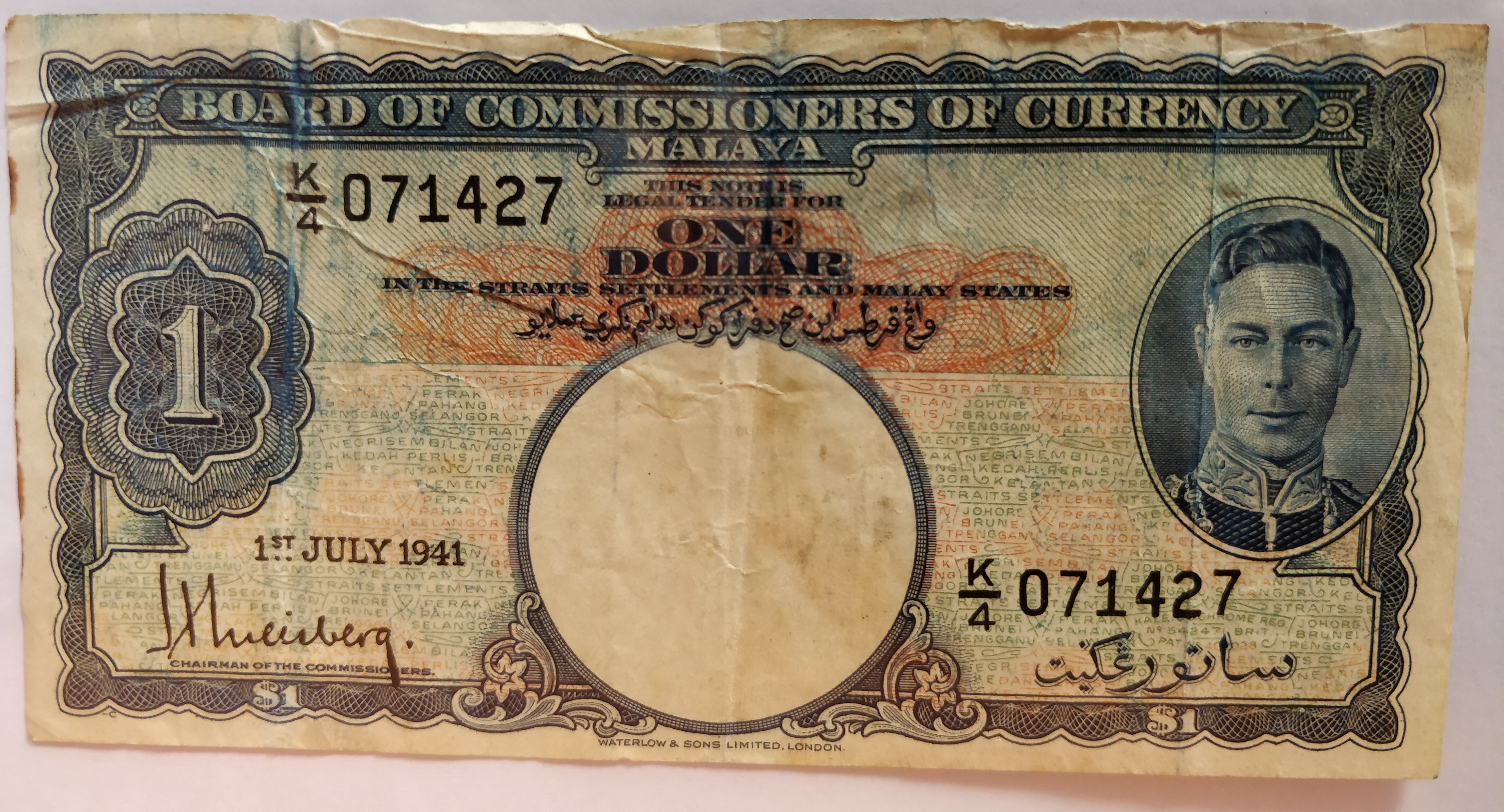 |
 |
$1 | Blue | 1941 | ||
| $5 | blue | 1940 | ||||
| $5 | Green/yellow | 1941 | ||||
| $10 | purple | 1940 | ||||
| $10 | Red | 1941 | ||||
| $50 | Blue/mauve | 1941 | ||||
| $100 | red/green | 1941 | ||||
| $1000 | blue/purple | 1941 | ||||
| $10,000 | green/light brown | 1941 | ||||
See also

